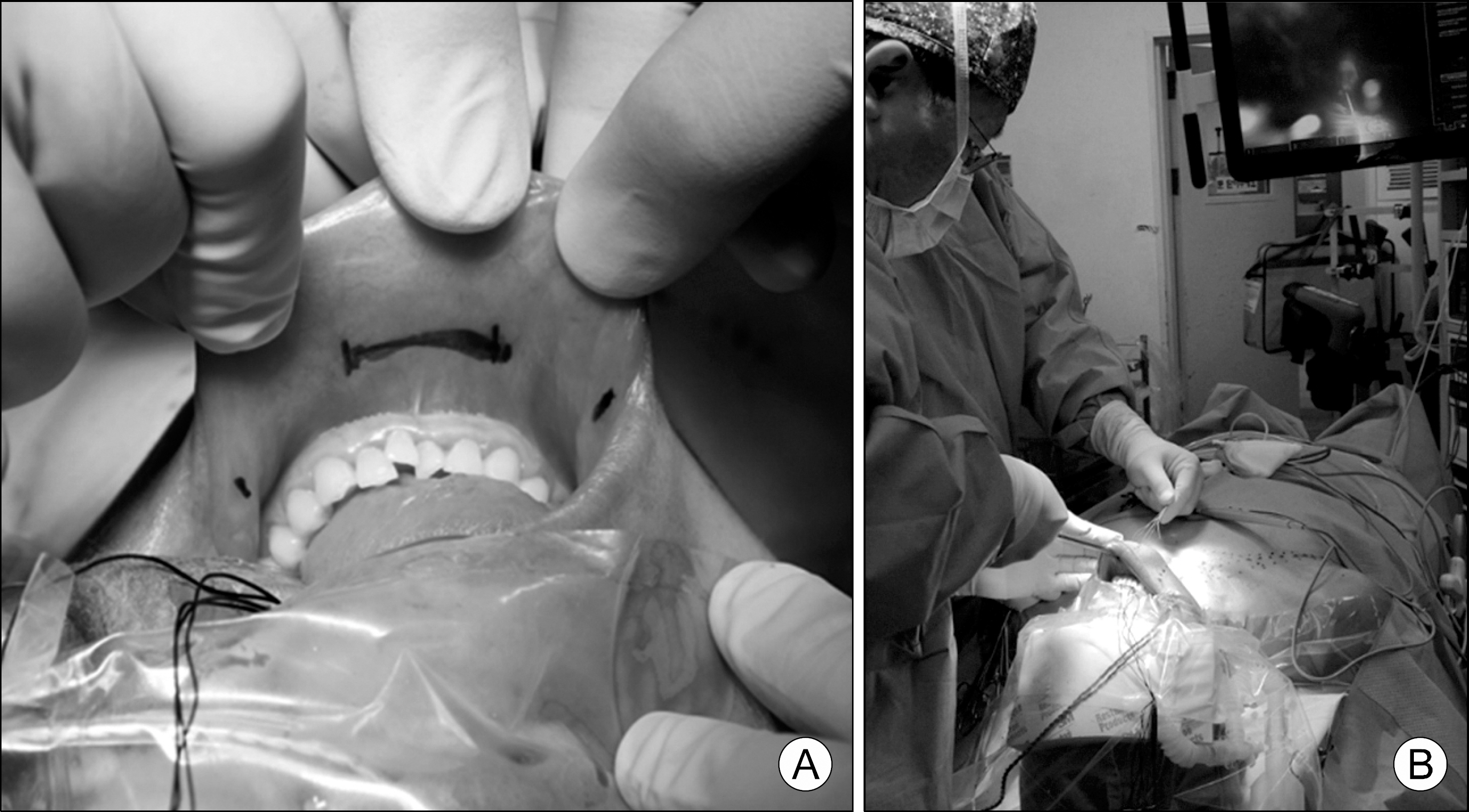Int J Thyroidol.
2018 May;11(1):26-30. 10.11106/ijt.2018.11.1.26.
Transoral Robotic Thyroidectomy
- Affiliations
-
- 1Department of Surgery, KUMC Thyroid Center, Korea University Anam Hospital, Korea University College of Medicine, Seoul, Korea. hoonyubkim@korea.ac.kr
- KMID: 2428068
- DOI: http://doi.org/10.11106/ijt.2018.11.1.26
Abstract
- Transoral approach for thyroidectomy recently gains a lot of attention among the thyroid surgeons, with definite merits over previously developed remote-access approaches. The approach not only resulted in the ideal cosmetic outcome but less postoperative pain with smaller dissection plane in comparison with other approaches. We have successfully introduced the robotic surgical system and its related techniques to this transoral surgical approach for thyroidectomy, which enables the surgeon to have the three-dimentional operative vision and to use the articulating instruments to enhance th eoptimal surgical outcomes. Herein, our unique procedures of transoral robotic thyroidectomy (TORT) are described, and possible advantages and disadvantages of the operation are discussed.
Figure
Reference
-
1). Gagner M. Endoscopic subtotal parathyroidectomy in patients with primary hyperparathyroidism. Br J Surg. 1996; 83(6):875.
Article2). Kang SW, Jeong JJ, Yun JS, Sung TY, Lee SC, Lee YS, et al. Gasless endoscopic thyroidectomy using trans-axillary approach; surgical outcome of 581 patients. Endocr J. 2009; 56(3):361–9.
Article3). Choi JY, Lee KE, Chung KW, Kim SW, Choe JH, Koo do H, et al. Endoscopic thyroidectomy via bilateral axillo-breast approach (BABA): review of 512 cases in a single institute. Surg Endosc. 2012; 26(4):948–55.
Article4). Wilhelm T, Metzig A. Endoscopic minimally invasive thyroidectomy (eMIT): a prospective proof-of-concept study in humans. World J Surg. 2011; 35(3):543–51.
Article5). Nakajo A, Arima H, Hirata M, Mizoguchi T, Kijima Y, Mori S, et al. TransOral Video-Assisted Neck Surgery (TOVANS). A new transoral technique of endoscopic thyroidectomy with gasless premandible approach. Surg Endosc. 2013; 27(4):1105–10.
Article6). Lee HY, Richmon JD, Walvekar RR, Holsinger C, Kim HY. Robotic transoral periosteal thyroidectomy (TOPOT): experience in two cadavers. J Laparoendosc Adv Surg Tech A. 2015; 25(2):139–42.
Article7). Lee HY, Hwang SB, Ahn KM, Lee JB, Bae JW, Kim HY. The safety of transoral periosteal thyroidectomy: results of Swine models. J Laparoendosc Adv Surg Tech A. 2014; 24(5):312–7.
Article8). Lee KE, Kim E, Koo do H, Choi JY, Kim KH, Youn YK. Robotic thyroidectomy by bilateral axillo-breast approach: review of 1,026 cases and surgical completeness. Surg Endosc. 2013; 27(8):2955–62.
Article9). Ban EJ, Yoo JY, Kim WW, Son HY, Park S, Lee SH, et al. Surgical complications after robotic thyroidectomy for thyroid carcinoma: a single center experience with 3,000 patients. Surg Endosc. 2014; 28(9):2555–63.
Article10). Richmon JD, Kim HY. Transoral robotic thyroidectomy (TORT): procedures and outcomes. Gland Surg. 2017; 6(3):285–9.
Article11). Lee HY, You JY, Woo SU, Son GS, Lee JB, Bae JW, et al. Transoral periosteal thyroidectomy: cadaver to human. Surg Endosc. 2015; 29(4):898–904.
Article
- Full Text Links
- Actions
-
Cited
- CITED
-
- Close
- Share
- Similar articles
-
- Robotic Transoral Thyroidectomy: Right Thyroidectomy and Ipsilateral Central Neck Dissection with da Vinci Si Surgical System
- Robotic transoral thyroidectomy for papillary thyroid carcinoma
- Transoral Robotic Thyroidectomy: The Overview and Suggestions for Future Research in New Minimally Invasive Thyroid Surgery
- Transoral Thyroidectomy: Advantages and Disadvantages
- Transoral Robotic Lingual Thyroidectomy




